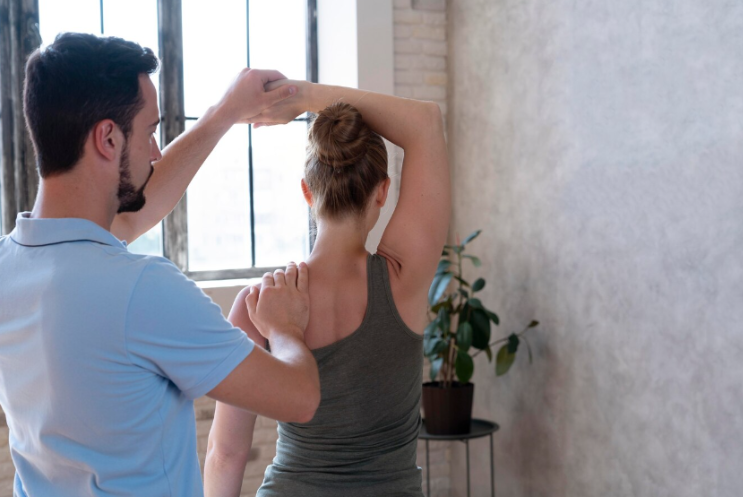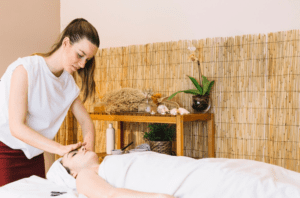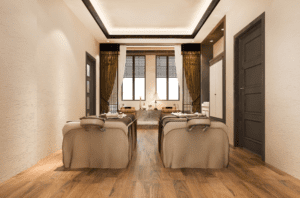Maintaining correct posture is one of the stepping stones on the way to general welfare. Sitting in an inappropriate position is often accompanied by adverse effects on the body’s physical and mental health, which can be signified by back pain, lowered mobility, and reduced self-assurance. Among the various ways to tackle the back issue, massage therapy, effective and interesting, is one of the most promising practices.
In this article, you will learn massage for posture as a tool will be featured. Apart from that, the article will highlight the benefits of massage therapy by providing some exercise tips.
Understanding Bad Posture
To understand what bad posture looks like, its causes, and its impacts on someone’s life, before we get to what massage therapy or massage for posture can do in fixing posture problems, it is essential to understand. Poor posture is a common problem that most people suffer from, and it is usually followed by neck or back pain after some activities or long sitting.
Medically speaking, bad posture occurs when the spinal cord stays in bent positions for extended periods, putting increased pressure on joints and ligaments. This pressure can lead to muscle imbalances and ultimately develop into a posture that is detrimental to our muscles and joints.
The most common cause of bad posture is prolonged sitting. Unfortunately, it is common to not sit with the correct posture for our spines, leading to muscle imbalances and the development of bad posture over time.
The Effects of Bad Posture
Bad posture can have various negative effects on our bodies, both physically and mentally. Some common effects of bad posture include:
- Experiencing pain in the upper and lower back, neck, and shoulders.
- Poor circulation potentially leads to issues like varicose veins.
- Digestive problems and slow digestion.
- Spine misalignment or curvature.
- Constriction of nerves.
These ailments can range from mildly uncomfortable to severely impairing, requiring additional treatment such as medications or physiotherapy. However, the good news is that many of these effects can be successfully prevented and treated with massage therapy.
Causes of Bad Posture
There are several causes of poor posture, with sitting in the wrong position for extended periods being the most prevalent. Taut muscles and the weightlessness of the upper body that poor posture causes exacerbate mental state conditions such as anxiety.
One of the implications of stress is that muscles tend to stiffen or force the muscles to contract excessively, which creates imbalances in posture. Credit in identifying and tackling the causes is a central factor that ensures proper posture and impeccable health.
Massage for Posture: How Can it Help?
Massage for posture can help fix incorrect posture that stands upon scientific principles. It is not only one of the pain methods but also can lift your mood and overstimulate your health. One may also benefit from different massages, which can be effective on one’s posture-related problems, such as deep tissue massage, sports massage, and Swedish massage.
1. Sports Massage
Contrary to its name, sports massage is not limited to athletes and active individuals. Such body massage is aimed at assessing the pressure of the inter-tissue (tendons and muscles of the body), which is applied according to the needs of an individual. Sports massage helps lessen pain and tension as it has a positive impact on blood circulation, muscle and joint flexibility, and muscle elasticity. By dealing with muscle imbalances that do occur as a result of unequal muscle engagements and muscle contractions, sports massage helps return the original posture.
2. Deep Tissue Massage
Similar to sports massage, deep tissue massage focuses on the soft tissues of the body. Deep tissue massage is effective in relaxing the muscles, improving flexibility, and relieving pain as it applies high force to the tissues. It is not shock therapy, but it works this way by correcting the posture problems on a deeper tissue level. This mental state brings about relief and ease of movement, which contributes to good posture and general wellness.
3. Swedish Massage
The Swedish massage is a flexible style, which may serve for physical treatment as well as mental relaxation. It entails kneading certain parts of the body to which stress is directed. Swedish massage treats the pain and stiffness in areas like the lower back or shoulders. It has to be noted that this type of massage offers general stress relief, hence, correct posture.
Techniques for Posture Improvement Therapy
Massage therapists use a range of massages for posture to improve posture and address specific issues. Some commonly used techniques involved in postural correction massage:
1. Deep Strokes
Deep strokes involve applying deep pressure with flattened hands and fingers to reach deep within muscle fibers. This technique aims to increase muscle temperature, improving tissue elasticity and flexibility. By reducing muscle tightness, deep strokes help improve posture and decrease pain.
2. Mobilizations
Mobilizations are manipulations applied along the spine to increase the range of movement at each joint. Rigidity within the area surrounding the spine induces bad posture that can result in more pain and discomfort. Mobilizations aid in reducing stress and tension and improve joint mobility, enabling normal posture recovery without pain.
3. Myofascial Release
Myofascial release targets soft tissues and fascia, the fibrous connective tissue that surrounds structures in the body. By stretching and loosening fascia tissues, myofascial release reduces restriction and pain. This reduction in restriction allows for a return to the original posture.
Physiological Effects of Massage to Improve Posture
During a massage session, several physiological effects contribute to the improvement of posture. These effects include:
Increased Vasodilation
Massage therapy promotes increased vasodilation, which widens blood vessels and improves blood flow. This increase in blood flow helps raise muscle temperature, promoting relaxation of tight muscles and reducing restriction. The relaxation of muscles and increased mobility contribute to improved posture.
Increased Temperature
Massage therapy also increases temperature within superficial and deep tissues, including fascia. The increase in temperature is the result of an improved circulation that is caused by friction. Elevated tissue temperature enhances tissue elasticity and suppleness, thereby creating improved flexibility and posture.
Increased Tissue Elasticity
Massage therapy enhances tissue elasticity by increasing flexibility and range of movement. Soft tissues and connective tissues like fascia become less limiting, curbing the limitations in the movements and improving posture. Massage therapy helps muscle tightness related to poor posture by promoting elasticization of the tissues.
When Can I Use Postural Correction Massage?
Massage therapy can help improve posture in various situations, including:
- Acute Pain: Massage therapy helps reduce pain caused by muscle tightness, joint stiffness, and restricted movement associated with poor posture.
- Relaxation: Improved posture leads to increased relaxation, both physically and mentally. Massage therapy relieves stress and tension, promoting relaxation and reducing pain.
- Tight Muscles: Massage therapy loosens tight muscles, allowing for increased flexibility and range of movement. This reduction in muscle tightness improves posture and decreases discomfort.
The Importance of Lifestyle Changes
While massage therapy can be highly beneficial for posture correction, it’s essential to complement it with lifestyle changes. Incorporating the following adjustments into your daily routine can significantly enhance the effectiveness of postural correction massage.
Avoid Sitting for Extended Periods
One of the most critical lifestyle changes is to avoid prolonged sitting. While many professions and activities require sitting, incorporating low-intensity activities like standing and walking can counteract the negative effects of extended sitting. Research has shown that replacing sitting time with standing or walking can significantly improve cardio-metabolic health.
Maintain a Straight Back
Maintaining a straight back is crucial for good posture. Esther Gokhale, an acupuncturist and author, studied indigenous cultures with lower rates of back pain and discovered that their spines had a different shape. Most individuals in industrialized societies have an S-shaped spine, while those in Indigenous communities have a J-shaped spine. By fixing the way we stand and sit, such as lengthening the spine and engaging the glute muscles, we can improve posture and reduce back pain.
Spend Less Time on Your Smartphone
Smartphone usage has become a significant contributing factor to poor posture. The sustained use of smartphones results in forward head posture and limitation in respiratory function. Studies have revealed that people who use their smartphones a lot have slouch and round shoulders. To counteract these influences, one should try to keep the spine neutral and not use a cell phone for too long.
Exercise and Stretch Consistently
Regular exercise and stretching are essential for improving posture. Flexibility and resistance training have been found to have a favorable impact on forward head posture and shoulder posture. In so doing, individual exercises that focus on the neck and shoulder muscles help to improve the body posture and minimize postural abnormalities.
The Advantages of Posture Improvement Therapy
Postural improvement is one of the many benefits of massage therapy in the context of the overall quality of life. Research works have always shown the effectiveness of massage in treating back pain and correcting postural deformities. Massage therapy can help improve shoulder range of motion, decrease lower back pain, and increase spinal flexibility. Alignment massage therapy assists the body in attaining better posture by relieving muscle tension and improving circulation.
Conclusion
Massage for posture involves a holistic and efficient method of improving posture. By dealing with muscle tension, letting go of tightness, and inducing a relaxed state, massage therapy ensures that proper alignment is restored and that postural issues are resolved. In combination with lifestyle changes, exercises, and stretches, massage therapy becomes very effective in obtaining long-term postural correction.
If you wish to work on your posture and general health, you may want to include massage therapy, among other methods. Visit Spa Utopia to explore a range of massage therapy services and find a qualified massage therapist near you.
Frequently Asked Questions
How often should I receive posture improvement therapy?
The frequency of posture improvement therapy depends on individual needs and goals. In general, starting with weekly or bi-weekly sessions can provide noticeable improvements. As posture improves, the frequency can be reduced to monthly or as needed for maintenance.
Can massage therapy alone fix my posture?
Although massage therapy has a big role in posture correction, lifestyle changes, exercises, and stretches should also be added. Massage therapy can relax muscles and release tension, but other strategies are needed for long-term postural betterment.
Are there any specific exercises to enhance the effects of posture improvement therapy?
Some various exercises and stretches can complement posture improvement therapy. Consult with a qualified healthcare professional or a massage therapist to determine the best exercises and stretches for your specific needs.
How long does it take to see improvements in posture through massage therapy?
The time it takes to see improvements in posture through massage therapy can vary depending on individual factors, such as the severity of the postural issues and the consistency of massage therapy sessions. Generally, consistent sessions over a few months can lead to noticeable improvements.
Can I perform self-massage techniques for posture improvement therapy?
Yes, there are self-massage techniques that can be performed at home to complement professional massage therapy sessions. Foam rollers, massage balls, and self-massage techniques can help release muscle tension and promote better posture. However, it is essential to learn these techniques properly to avoid any potential harm.





